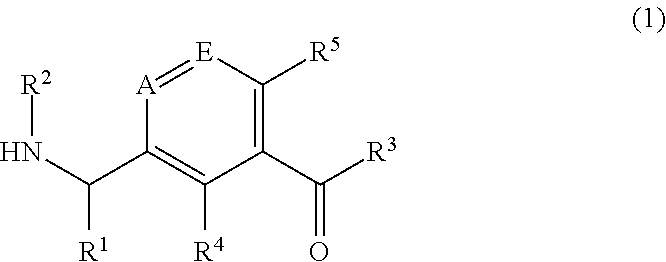Pharmaceutical compounds
a technology of pharmaceutical compounds and compounds, applied in the field of pharmaceutical compounds, can solve the problems of insufficient curative effect of transplantation, high cost of hcv infection treatment, and large patient population, and leave a large group of patients without treatment alternatives
- Summary
- Abstract
- Description
- Claims
- Application Information
AI Technical Summary
Benefits of technology
Problems solved by technology
Method used
Image
Examples
example 1
[0585]
Step 1
[0586]To a solution of Intermediate 2 (8 g, 27.8 mmol) in dry THF (200 mL) under nitrogen at −78 degC was added n-BuLi (2.5M in hexanes, 24.5 mL, 61.2 mmol, 2.2 eq.) dropwise and the solution stirred at −78 degC for 1 h. Ethyl 6-chloronicotinate (4.3 mL, 30.6 mmol, 1.1 eq.) was added quickly and the reaction stirred for a further 30 min before it was quenched with NH4Cl (aq.). Once warmed to room temperature, the mixture was partitioned between EtOAc (200 mL) and water (200 mL). The organic phase was washed with water (200 mL) and brine (100 mL) before it was dried (MgSO4), filtered and concentrated. The material was triturated with Et2O twice to give 2 crops of {(R)-1-[4-chloro-3-(6-chloro-pyridine-3-carbonyl)-2-fluoro-phenyl]-propyl}-carbamic acid tert-butyl ester, totalling (6.4 g, 15 mmol, 54%) between them. [MH]+ 371
Step 2
[0587]{(R)-1-[4-Chloro-3-(6-chloro-pyridine-3-carbonyl)-2-fluoro-phenyl]-propyl}-carbamic acid tert-butyl ester (6.4 g, 15 mmol) was suspended in ...
example 2
[0589]
Step 1
[0590]To a solution of Intermediate 2 (13.7 g, 147.6 mmol) in dry THF (330 mL) under nitrogen at −78 degC was added nBuLi (2.5M in hexanes, 43.8 mL, 110 mmol, 2.3 eq.) dropwise and the solution stirred at −78 degC for 1 h. Ethyl nicotinate (9.6 mL, 61.9 mmol, 1.3 eq.) was then added. Reaction left at −78 degC for 45 minutes and was then quenched first with MeOH (˜10 mL) and then water (˜20 mL). Concentrated and then partitioned between EtOAc (400 mL) and water (300 mL). Organic phase was washed with water (300 mL) and brine (100 mL) before it was dried (MgSO4), filtered and concentrated to give crude material (˜23 g). Purified by silica column (65M on Biotage SP4) eluting 20-35% EtOAc in petroleum ether over 15 column volumes to give {(R)-1-[4-chloro-2-fluoro-3-(pyridine-3-carbonyl)-phenyl]-propyl}-carbamic acid tert-butyl ester (16.0 g, 40.7 mmol, 86%). [MH]+ 393
Step 2
[0591]To a solution of {(R)-1-[4-chloro-2-fluoro-3-(pyridine-3-carbonyl)-phenyl]-propyl}-carbamic acid ...
example 3
[0592]
Step 1 Conducted as Step 1 towards Example 1 using Intermediate 6 and methyl 5-chloropyrazine-2-carboxylate. [M−H]− 438
Step 2
[0593]{(R)-[4-Chloro-3-(5-chloro-pyrazine-2-carbonyl)-2-fluoro-phenyl]-cyclopropyl-methyl}-carbamic acid tert-butyl ester (709 mg, 1.61 mmol), 4-methoxybenzylamine (0.232 ml, 1.77 mmol), triethylamine (0.448 ml, 3.22 mmol) and dimethylformamide (5 ml) was heated to 80 deg C for 3 hours. The reaction was allowed to cool, ethyl acetate was added, and the mixture was washed with 10% aqueous lithium chloride solution and brine. The organic liquors were dried (MgSO4) and concentrated. The residue was purified by column chromatography eluting with 10-50% ethyl acetate / petroleum ether furnishing ((R)-{4-Chloro-2-fluoro-3-[5-(4-methoxy-benzylamino)-pyrazine-2-carbonyl]-phenyl}-cyclopropyl-methyl)-carbamic acid tert-butyl ester (512 mg) as a yellow oil. [M+H]+ 541
Step 3
[0594]The product from Step 2 (512 mg) was heated to 60 deg C in a solution of trifluoroacetic ...
PUM
| Property | Measurement | Unit |
|---|---|---|
| Stereoisomer | aaaaa | aaaaa |
Abstract
Description
Claims
Application Information
 Login to View More
Login to View More - R&D
- Intellectual Property
- Life Sciences
- Materials
- Tech Scout
- Unparalleled Data Quality
- Higher Quality Content
- 60% Fewer Hallucinations
Browse by: Latest US Patents, China's latest patents, Technical Efficacy Thesaurus, Application Domain, Technology Topic, Popular Technical Reports.
© 2025 PatSnap. All rights reserved.Legal|Privacy policy|Modern Slavery Act Transparency Statement|Sitemap|About US| Contact US: help@patsnap.com



